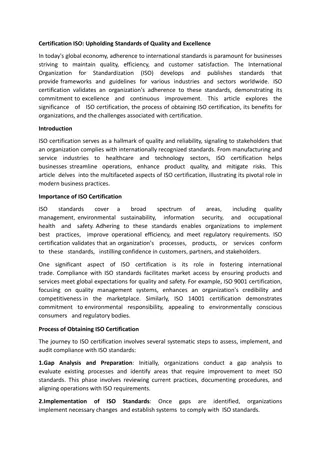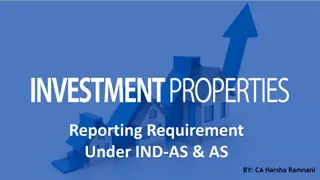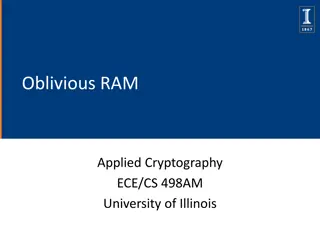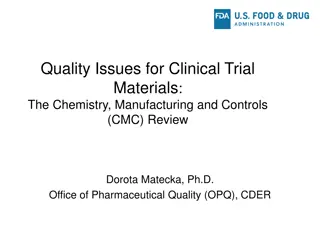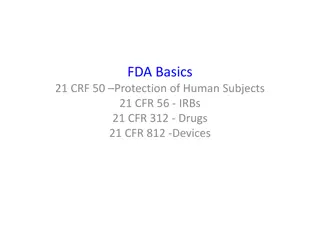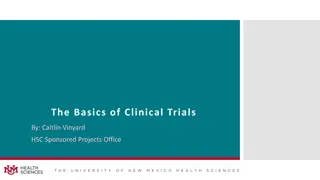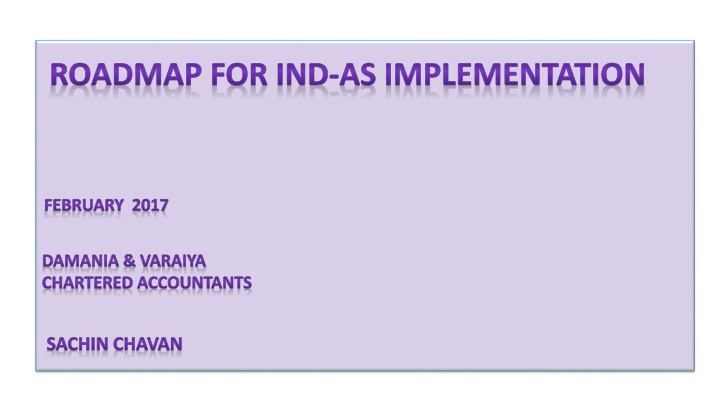
Indian Accounting Standards Implementation Roadmap
"Learn about the implementation timeline for Indian Accounting Standards (Ind AS) including applicability, exemptions, and phases for companies in India. Find out which companies need to comply and when, as well as key dates and requirements for first-time adoption."
Uploaded on | 0 Views
Download Presentation

Please find below an Image/Link to download the presentation.
The content on the website is provided AS IS for your information and personal use only. It may not be sold, licensed, or shared on other websites without obtaining consent from the author. If you encounter any issues during the download, it is possible that the publisher has removed the file from their server.
You are allowed to download the files provided on this website for personal or commercial use, subject to the condition that they are used lawfully. All files are the property of their respective owners.
The content on the website is provided AS IS for your information and personal use only. It may not be sold, licensed, or shared on other websites without obtaining consent from the author.
E N D
Presentation Transcript
ROADMAP FOR IND-AS IMPLEMENTATION FEBRUARY 2017 DAMANIA & VARAIYA CHARTERED ACCOUNTANTS SACHIN CHAVAN
Applicability of Indian Accounting Standards (Ind AS) Voluntary compliance Mandatory Compliance Voluntary compliance Any company may comply with Indian AS for Financial statements beginning with period on or after 1stApril 2015, with the comparatives of period ending on 31stMarch, 2015, or thereafter Exemptions: The insurance companies, banking companies and non-banking finance companies(NBFC) shall not be required to apply Indian Accounting Standards (Ind AS) for preparation of their financial statements either voluntarily or mandatorily.
First Time Adoption of IND AS Phase I Ind AS will be mandatorily applicable to the following companies for periods beginning on or after 1 April 2016, with comparatives for the period ending 31 March 2016 or thereafter: 1.Companies whose equity and/or debt securities are listed or are in the process of being listed on any stock exchange in India or outside India and having net worth of rupees 500 Crore or more. 2.Companies other than above and having net worth of Rs. 500 Crore or more; 3.Holding, subsidiary, joint venture or associate companies of above companies.
IND AS is applicable by virtue of Phase 1 2015-16 2016-17 April March March April MANDATORY PHASE - 1 Financial Statements for year ended 31 March 2017 Comparative 31 March 2016 Opening Balance Sheet 1 April 2015
First Time Adoption of IND AS Phase II Ind AS will be mandatorily applicable to the following companies for periods beginning on or after 1 April 2017, with comparatives for the period ending 31 March 2017 or thereafter: 1.Companies whose equity and/or debt securities are listed or are in the process of being listed on any stock exchange in India or outside India and having net worth of less than rupees 500 Crore. 2.Unlisted companies other than those covered in Phase I whose net worth are more than 250 crore INR but less than 500 crore INR. 3.Holding, subsidiary, joint venture or associate companies of above companies.
IND AS is applicable by virtue of Phase 2 2016-17 2017-18 April March April March MANDATORY PHASE - 2 Financial Statements for year ended 31 March 2018 Comparative 31 March 2017 Opening Balance Sheet 1 April 2016
The first Ind AS financial statements shall include at least: Three Balance Sheets (as at 1st April, 2016, 31st March 2017 and 31st March 2018) Two Statements of Profit and Loss (for period ended on 31st March 2017 and 31st March 2018) Two Statements of cash flows (for period ended on 31st March 2017 and 31st March 2018) Two Statements of changes in equity (for period ended on 31st March 2017 and 31st March 2018) Related notes including summary of accounting policies and other explanatory information including comparatives.
SEBI LODR Requirement for F.Y. 2017-2018 SEBI relaxation for quarterly filing norms for first-time adopters as per Phase 2 The relaxation has been spread across two phases : For quarter ending 1) June 30, 2017 and September 30, 2017 and 2) December 31, 2017 For quarter ending June 30, 2017 and September 30, 2017, companies have been granted the following relaxations: a) Extension of the timeline for reporting of the financial statements by one month i.e. The results for the quarter ending June 30, 2017 & September 30, 2017 may be submitted by September 14, 2017 and December 14, 2017 respectively; b) For quarter ending June 30, 2017, IND AS compliant financial results for corresponding quarter ending June 30, 2016 shall be provided (wherein limited review/audit will not be compulsory);
c) For quarter ending September 30, 2017, IND AS compliant financial results for corresponding year to date/ quarter ending September 30, 2016 shall be provided (wherein limited review/audit will not be compulsory); d) For quarter ending June 30, 2017 and September 30, 2016, submission of IND AS compliant financial results for preceding quarter ending and previous year ending March 31, 2017 is not mandatory. However, if the company opts to do so, the same may be without audit/limited review; Further for quarter ending December 31, 2017, submission of IND AS compliant financial results for the previous year ending March 31, 2017 is not mandatory. However, if the company opts to do so, the same shall be subject to audit/limited review. Companies currently have a one time yearly choice (in line with the listing agreement) in first quarter of either reporting standalone or consolidated quarterly financials. For first time adopter of Ind AS, this option will also be available in second quarter this year.
Timelinefor Submitting Quarterly Financial Results Quarters Ending Existing Due Date Revised Due Date 30 June 2017 Upto 14 August 2017 Upto 14 September 2017 September 2017 Upto 14 November 2017 Upto 14 December 2017 31 December 2017 Upto 14 February 2018 Upto 14 February 2018 31 March 2017 Upto 30 May 2018 Upto 30 May 2018
The SEBI Circular provides relaxations from providing certain comparative as can be seen from below table Reporting requirement 3 month ended Preceding 3 month ended Corresponding 3 month ended in Previous Year Year to date figures for current period ended Year to date figures for previous year ended Previous year ended 31 march 2017 Audit/ review of period ended 31 march 2017 Audit or review of previous year comparative period Disclosure of reserve(excl uding revaluation reserve ) 30th June 2017 NA NA Optional (Note 2) (Note 4) (Note 2) 30 Sept. 2017 Optional (Note 2) (Note 4) (Note 2) 31 Dec. 2017 optional (Note 3)# (Note 3)# 31 March 2018 (Note 1) (Note 1) # : submission of IND AS Compliant financial results for the previous year ended 31 March 2017 is not mandatory. Note : 1) it requires reporting for financial year (FY) ended 31 March 2018 or 31 March 2017 2) Companies may voluntary provides IND AS comparatives for the year ended 31 March 2017. However , these are not require to be audited or reviewed. Company should disclose the fact that the financial result have been audited and reviewed. 3) If Company opts to provide IND AS comparatives for the year ended 31 march 2017, then such comparatives would require to be audited. 4) IND as quarterly financial result for the comparative period are not require to audited or reviewed. Company should disclosed the fact that financial result are not audited or reviewed
IND AS 2 - INVENTORIES By: Sachin Chavan
INTRODUCTION Ind AS 2 Inventories , prescribe the accounting treatment for inventories. The areas dealt in this standard are: Measurement (Initial & Subsequent) Disclosures
SCOPE EXCLUSIONS IND AS 2 does not apply to: Financial instruments (covered in Ind AS 109 Financial Instruments and Ind AS 32 Financial Instruments: Presentation ) Biological assets ( Living Animals or plant ) (Ind AS 41 Agriculture) IND AS 2 does not apply to the measurement of inventories held by: Producers of agricultural and forest products being measured at Net realizable value (NRV) Minerals and mineral products being measured at NRV Commodity brokers who measure such inventory at fair value less costs to sell.
DEFINITION Inventories are assets: Held for sale in ordinary course of business In the process of production for such sale In the form of materials or supplies to be consumed in the production process or in the rendering of services.
INITIAL MEASUREMENT The costs attributed to inventories under Ind AS 2 comprises of: Purchase price Import duties Other taxes (other than those recoverable from tax authorities) Transport, and handling charges Other cost directly attributable to inventories Trade discounts, rebates are deducted from the cost of purchase Cost of purchase Costs directly related to unit of production Allocation of fixed and variable production overheads Cost of conversion Only if incurred in bringing the inventories to their present location and condition Other costs
WHAT MAY BE INCLUDED IN COST? At Cost which: includes- excludes- Costs of purchase including non-recoverable taxes, transport and handling Abnormal waste Net of trade volume rebates Storage costs (unless necessary for the production process) Costs of conversion Admin overheads not related to production Other costs to bring inventory into its present condition and location. Selling costs Interest cost (where settlement is deferred)
SUBSEQUENT MEASUREMENT Cost Measurement Lower of or Net Realisable Value (NRV)
COST MEASUREMENT TECHNIQUES AND FORMULAS Cost Measurement Techniques Standard cost method Retail method Cost Formulas FIFO Weighted average cost For non-interchangeable items Specific identification LIFO is prohibited
NET REALIZABLE METHOD NRV Estimated selling price in the ordinary course of business Estimated costs necessary to make the sale Estimated costs of completion Note - Fair value is defined, as in IND AS 113 Fair Value Measurement, as 'the price that would be received to sell an asset or paid to transfer a liability in an orderly transaction between market participants at the measurement date.' The standard points out that net realisable value is an entity-specific value, the amount that the entity actually expects to make from selling that particular inventory, while fair value is not.
RECOGNITION IN P&L Ind AS 2 specifies that when inventory is sold, the carrying amount of the inventory must be recognised as an expense in the period in which the revenue is recognised. Inventory that goes into the creation of another asset, for instance into a self-constructed item of PP&E, would form part of the cost of that asset. Subsequently these costs are expensed through the depreciation of that item of PP&E during its useful life. Any write-downs or losses of inventory must be recognised as an expense when the write-down or loss occurs. Reversals of previous write-downs are recognised as a reduction in the inventory expense recognised in the period in which the reversal occurs.
DISCLOSURES accounting policies along with the cost formula carrying amount of inventories total and class wise carrying amount of inventories carried at fair value less costs to sell; amount of inventories recognised as an expense during the period; amount of any write-down of inventories recognised as an expense in the period; amount of any reversal of any write-down that is recognised as a reduction in the amount of inventories recognised as expense in the period; circumstances or events that led to the reversal of a write-down of inventories; and carrying amount of inventories pledged as security for liabilities.
TRANSITIONAL PROVISIONS AND CARVE OUTS FROM IFRS Carve Out from IFRS In principle there is no difference between Ind AS and IFRS but Ind AS 1 has carve out which impacts the presentation of inventories which is as discussed below. Under IAS 1, an entity shall present an analysis of expenses recognised in profit or loss using a classification based on either their nature or their function within the entity, whichever provides information that is reliable and more relevant. Whereas Ind AS 1 requires only nature- wise classification of expenses.
IND AS 2 VS AS 2 Particulars IND AS 2 AS 2 Cost formulae Consistent application same cost formula for all inventories that have a similar nature and use to the entity. It is not expressly mandated to use the same cost formula consistently for all inventories that have a similar nature and use to the entity instead it shall reflect the fairest possible approximation to the cost incurred. Inventories acquired on deferred settlement terms Specifically requires that where an inventory is acquired on deferred settlement terms, the entity needs to identify finance element separately. Not contain any specific requirement for separation of finance element.




